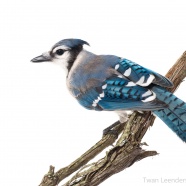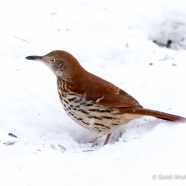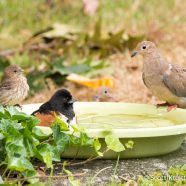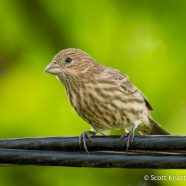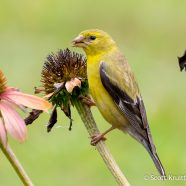Winter Blues
Blue Jays (Cyanocitta cristata) can look so vibrantly blue on sunny days, but blue coloration in animals is very rarely created by blue pigment. Instead, their stunning hues are created by refractive colors of light, breaking on microscopic structure of the feathers. Minute barbs on their feathers are specially modified to scatter light in a way that makes them appear blue, rather than showing the brown melanin that their feathers are colored with. Yes, Blue Jays are not actually blue!
Read MoreBrown Thrasher Visit
This Brown Thrasher came to my feeders today! Talk about a welcome visitor…it ended up spending the day eating with various feathered friends, using that long bill to dig seed out of the snow. It was a delightful surprise for one of the more quiet times of the year. Scott Kruitbosch Conservation & Outreach Coordinator
Read MoreBird Baths
Here is a great example of how you do not need to break your budget while attracting birds to your yard. Putting out bird seed, suet and so forth and making a home feeding station brings in all sorts of feather friends, as can erecting nest boxes for specific species, creating a brush pile, allowing grass and flowers to grow for natural seeds and nectar, or giving them nest building materials like fur. However, even some just regularly provided clean water can do the trick, especially in times of extreme heat, drought, or frigid cold (if heated!). Here is little more than a plastic tray with...
Read MoreFemale House Finch
This female House Finch (Haemorhous mexicanus) is already a feeder friend – have you filled your bird feeding stations yet this fall?
Read MoreAmerican Goldfinch Eating Coneflowers
Finally! It took me a while, but here is photographic proof of why you should not cut any dead coneflower heads. This American Goldfinch was chowing down and enjoying it so much that it ignored me. I frequently hear and occasionally see them dining like this, but never when my camera is near or I am close to them. Many plants end up producing delicious seeds in their…less aesthetically pleasing stages…and should be left alone as a meal for many forms of wildlife, or even just to propagate their species. Scott Kruitbosch Conservation & Outreach Coordinator
Read More



